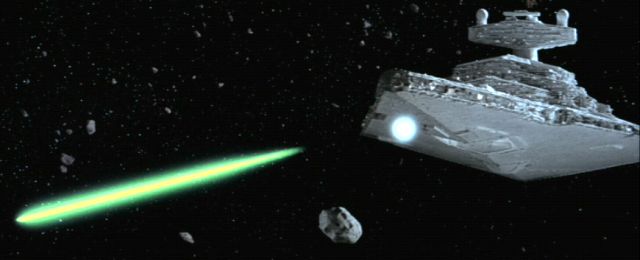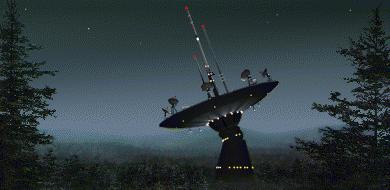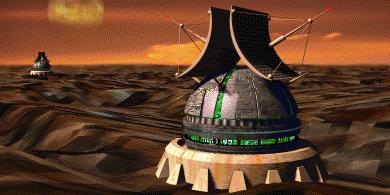Star Wars: Imperial Shields
Starship Shields | Planetary Shields
Written: 1998.08.01
Last Revised: 1999.10.06

A small 10m asteroid strikes an ISD's ventral shields with
roughly 2 TJ of kinetic energy and explodes harmlessly
Energy Handling
There are three common methods of estimating Star Destroyer shield strength, although accurate estimates are elusive:
TESB asteroid field. The TESB novelization described a "steady rain" of asteroids, and Anakin Skywalker: The Story of Darth Vader said that "turbolaser gunners blasted the largest rocks; those they missed impacted against the bow shields like multi-megaton compression bombs." We can see from the film that the ships were taking impacts at the rate of at least 1 asteroid per second if not more, and we know from the above quote that the asteroids were striking with several megatons of energy each. Some Federation cultists dispute this figure by stating that we saw some slow-moving asteroids in the films, but this is a false dilemma fallacy: the existence of slow-moving asteroids does not prove that all of the asteroids (<99.99% of which would have impacted >off-screen) would have been slow-moving, particularly since typical asteroid speeds in the Earth's solar system have been observed to be much higher than this. Furthermore, the bombardment must have continued for at least 1 or 2 days because Vader had time to contact bounty hunters, who travelled from their various homebases to the Outer Rim while the fleet stayed in the field. Therefore, each ISD might have absorbed as much as 3E20 joules of kinetic energy while in the asteroid field.
ROTJ battle. Star Destroyers were able to survive half an hour of ship to ship battle with Mon Calamari battlecruisers in the Battle of Endor before they started to lose shielding. If we assume roughly one Star Destroyer per Mon Calamari cruiser and ignore fighters (in spite of the fact that they were carrying thermonuclear weapons), we can estimate that a Star Destroyer can survive many thousands of shots before shield failure. In the opening scene of ANH a Star Destroyer is seen firing roughly 25 shots in 5 seconds, for a time-averaged refire rate of 5 shots per second. As discussed in the turbolaser page, each shot carries at least 1.5E15 joules of energy, and around 1E17 joules of energy if set to maximum power. If similar fire rates occured in the Endor battle (note that we are disregarding the heavy turbolasers which would increase the estimate by an order of magnitude), this means that the energy capacity of a Star Destroyer's shields is between 1.4E19 and 9E20 joules, so 1E20 joules (24,000 megatons) is a reasonable estimate.
Characteristics of offensive weaponry. An ISD1 can unleash more than 6E19 joules (14,000 megatons) of energy with a full broadside. If an ISD can withstand at least one full broadside from another ISD, then this would mean that the burst energy capacity of a Star Destroyer's shields is probably in the range of 1E19 joules.
Federation cultist misconceptions
Federation cultists have propagated numerous myths about Imperial shielding:
No particle shielding. They claim that deflector shields can't stop matter, based on the assumption that the DS1 exhaust port ray-shield was the only type of shield in the Empire. This is obviously untrue. Not only are particle-shields referenced in the SWEGWT as well as every other official source, but we saw specialized particle-shields in TPM such as the Gungan "hydrostatic" field that kept water out of the Otoh Gunga underwater city-spheres as well as the "Bongo" personal watercraft. Furthermore, the canon ANH novelization clearly states that the Falcon's deflector shields saved it from instant destruction when it emerged from hyperspace into the "meteor shower" that was Alderaan. As usual, they attempt to contradict this canon information with numerous misinterpretations:
They note that an asteroid struck the Falcon's hull in TESB, but the Falcon had its shield power redirected to aft shields due to the relentless pursuit and the asteroid would have logically hit the front part of the ship. Furthermore, some types of particle-shield exist on and below the surface of the armour according to the SWEGWT, so a physical object will strike the combined shield/armour at once.
They point out that the ISD's shields didn't stop the Falcon from landing on the bridge tower in TESB, but it must be stressed that it did not land immediately. It could have hovered in the sensor blind spot until the shields were dropped. Another possibility is that its magnetic clamp was able to secure it to the hull even though the shields were up, since the particle shields are so close to the hull.
They point out that the TESB novelization described asteroids striking the "hull" of an ISD, but they ignore the twin possibilities that the ISD shields were down, or that the particle-shield and hull are interchangeable concepts since some types of particle-shield exist on and beneath the surface of the hull.
The A-wing fighter that damaged the Executor's bridge tower didn't make its suicide attack until after the Executor's bridge deflector shields were dropped. If deflector shields were impotent against physical collisions, there would have been no reason to wait until the Executor's shields were dropped.
Frequency of vulnerability. It is often assumed that Imperial shields have a frequency to which they are vulnerable, much like Federation shields. Since no operating frequency has ever been mentioned or referenced in any official or canon source, and since the cultists give no justification for this claim other than the fact that Federation shields have a vulnerable frequency (thus assuming that Imperial shields and Federation shields use similar technology), there is no reason to grant any credence to this claim.
Sparse fire at Endor. For some incomprehensible reason, they claim that no full salvoes were used in the Battle of Endor despite the novelization's explicit descriptions. They should be mindful of the fact that unless specifically contradicted by the films, the novelizations are canon. They should also be mindful of the fact that from Luke's vantage point on the Death Star, the two fleets can be seen exchanging fire from extreme long distance, with flashes of light clearly visible. They clearly fail to recognize that small 1-metre wide light turbolaser shots would be invisible to the naked eye at such long distance (hundreds of kilometres). The fact that some shots are visible indicates that heavy turbolasers must be in use, not that an incredibly sparse number of light turbolaser shots are being fired. As our own records show (as well as the ROTJ novelization), all of the capital ships in the Battle of Endor were exchanging massive long-range turbolaser fire, which only intensified as the fleets moved towards each other.
Power vs Energy. It has often been noted that the above analyses concentrate almost entirely on energy, rather than discussing power. Some cultists go so far as to claim that the analyses are invalid for this reason, since power and energy must both be discussed. There are several reasons for the one-sided emphasis on energy over power in this discussion:
Energy is work. Power is only the rate at which work is done, and although some laypeople seem to think that power is more important, energy is actually more important in collisions, weapon discharges, armour resistance, etc. The physics of collisions are based entirely on kinetic energy and momentum, with power being irrelevant. Weapons such as projectile launchers or nuclear warheads are always rated in terms of energy yield, with power being irrelevant. The stress-strain curves and material toughness specifications of engineering materials are based entirely on energy, with power being irrelevant.
The problem with a lot of Federation cultist laypeople is that they seem to think that science and engineering are a mere numbers game, and one must simply look for the largest number. That is not the way it works- the numbers are only relevant if they describe quantities which are directly applicable to the situation. Power is only important if the rate of energy application is extremely low, and even in that case, it is still subordinate to energy limitations.
Shields do not seem to be steady-state devices. Instead, they appear to have a reservoir of energy-handling capacity, which drains with each hit (similar to Federation shields). This is substantiated by various depictions in the novels, as well as numerous incidents from the films ("Sir, one more hit on the back quarter and we're done for!"). This means that a certain amount of work is necessary to overcome the shields, and there is no reason to believe that power is any more relevant here than it is in the physics of collisions and material deformation/damage.
Among the characteristics of Imperial shields is the ability to easily withstand direct hits from thermonuclear weapons, as indicated by the fact that Ackbar's warship took direct hits from such weapons at the beginning of the Battle of Endor, from the Imperial fighters (before engaging the Imperial fleet). Even a 20th century low-yield tactical thermonuclear (ie- nuclear fusion with nuclear fission detonator) weapon will have a peak power output in excess of 1E20 watts, never mind the high-yield weaponry available to a galactic civilization. Therefore, any attempt to shift the discussion from energy to power is pointless. Shields can handle high power more easily than they handle high energy.
Nkllon-derived upper limit. Some Federation cultists point to the Nkllon incident in Heir to the Empire, in which the ISD Judicator suffered damage while orbiting the planet Nkllon, which closely orbits its sun Athega. However, there are several problems with this line of reasoning:
The characteristics of that star and planet are completely unknown- the star is described as super-hot in the SWE and the planet is obviously composed of extremely unusual minerals since Lando felt its mineral wealth was worth the expensive and dangerous undertaking of mining it, in spite of the fact that millions of other planets were accessible.
The shield-ships survived prolonged proximity to Nkllon even though they were actually unshielded vessels.
Based on the shield-ships, Nkllon was extremely close to its star, and suffering radiative bombardment equal to being deep in the corona of Sol.
The incident is official but non-canon and therefore overriden by the TESB and ROTJ canon evidence.
Heavy damage to the ship was not confirmed. In fact, the only descriptions of the damage came from Rebels, who speak from a seriously biased standpoint. Pallaeon reported that it would only take a few weeks to repair the damage, and one can surmise that it was probably confined to delicate items like sensor arrays, communications antennae, and perhaps exposed light gun barrels. At no time was the ship in any threat of being destroyed, not even in the biased evaluation of Rebels at the scene.
The Judicator started taking damage immediately after entering the area, which suggested that the solar radiation actually penetrated its shields even though they were still up. Furthermore, there was no sharp increase in damage level- the ship was taking damage continually while it was in the vicinity of Nkllon. There are several possible explanations for this phenomenon:
The Judicator entered the system with shields down. This would seem to be rather unlikely, since it is difficult to concoct a reason why they would do this.
The shields permitted enough stellar radiation through, even while up, to damage components on the ship's surface. This is distinctly possible. We know that, failing all else, the shields must allow visible-spectrum electromagnetic radiation to pass, since we can see the ships and their crew can see external objects through the windows.
The damaged components were weakly shielded by design. This is also distinctly possible. The efficiency of communications antennae and sensor arrays will obviously be adversely affected by highly opaque shielding, and the shielding may be deliberately semi-permeable to a wider range of electromagnetic radiation frequencies than the normal shielding over heavy armour.
TESB-derived upper limit. A 70m asteroid struck an ISD bridge tower in TESB, and some Federation cultists have interpreted this to represent an upper limit on ISD bridge tower shielding. This is a typical Federation cultist false cause fallacy, which is explored in somewhat greater depth in the Debating Fallacies page.
Shield generator globes. A common misconception, supported by some of the poorly researched WEG official literature, is that the twin globes on the top of an ISD's bridge tower generate its shields (a second misconception is that one can knock out an ISD's shields by attacking the globes- this misconception is an example of the false fause fallacy and is discussed in the Debating Fallacies page). This misconception is discussed in great detail at the Star Wars Technical Commentaries page.
Trivia
Two civilian freighters (Han Solo's Millenium Falcon and Salla Zend's Rimrunner) both flew within 1000km of a neutron star in Rebel Dawn, without any damage whatsoever. They were racing through the Maw, which is described as "a treacherous, roughly spherical region of space containing black holes, neutron stars, and a few scattered main-sequence stars." Salla foolishly attempted a hyperspace micro-jump in the deadly Maw and dropped into realspace within 1000km of a neutron star- the shock of being forced into realspace under those conditions badly damaged her vessel, so the Millenium Falcon had to fly to the crippled Rimrunner's location to rescue her. The gravity that close to a neutron star is on the order of 200 million m/s², or 20 million g's, yet neither Solo or Zend suffered any ill effects. This establishes the ability of low-powered shields and inertial damper systems to protect against the effects of massive gravitational fields and intense electromagnetic radiation.
The aforementioned capabilities are superior to those of top-of-the-line Federation starships. In "Allegiance", Data stated that the Enterprise-D would "not survive" approaching to within 10 million kilometres of a pulsar. This could not have been a gravitational concern, since the gravitational acceleration at 10 million kilometres from a neutron star is a pitiful 2 m/s², or 0.2g's. Therefore, Data must have been concerned about the intense electromagnetic radiation coming from the pulsar.
|
A type of inexpensive planetary shield generator known as the GenCore Series II |
Planetary Energy Shields
"My Lord, the fleet has moved out of light-speed. Comm-Scan has detected an energy field protecting an area of the sixth planet of the Hoth system. The field is strong enough to deflect any bombardment"- General Veers, TESB. Planetary energy shields were used in TESB and ROTJ, but the Rebels' primitive Hoth energy shield was not at all similar to the sophisticated planetary energy shield in ROTJ which could prevent any and all ground attacks (unlike the Hoth shield), while simultaneously protecting the orbiting DS2. The Hoth energy shield essentially formed a "canopy" which ground forces could penetrate easily, while the Endor energy shield completely encircled the Endor moon as well as the DS2, leaving no openings through which to launch a ground assault.
The Rebels' primitive Hoth energy shield was therefore capable of withstanding the full bombardment of 5 ISD's and 1 SSD, carrying an order of magnitude more firepower than a Base-Delta-Zero operation would require, indefinitely (in other words, >5 billion TW). Most significantly, this energy shield paled in comparison to the massive planetary energy shields erected at well-defended planets like the Endor sanctuary moon, Coruscant, and Byss (among others). This is one of the primary reasons that our strategists valued the Death Star, and why we built a second Death Star even after the first one was destroyed in the disastrous Battle of Yavin. Only truly massive firepower can penetrate the sophisticated planetary energy shields used in the Star Wars galaxy. As far back as the Clone Wars, planetary energy shields had the capability to resist Base-Delta-Zero firepower; the surface of Caamas was "burned off" in a Base-Delta-Zero operation just after the Clone Wars, long before the events depicted in ANH. No one survived (the only Caamasi survivors were off-world at the time, thus indicating the speed of a Base-Delta-Zero operation), but the planet was immune to attack until Bothan spies disabled the planet's shield generators (ref. Spectre of the Past). The Caamas incident demonstrates the speed and lethality of Base-Delta-Zero operations; no one was able to evacuate from the planet, and its surface was so completely destroyed that it was still uninhabitable decades later. It also demonstrates the effectiveness of planetary energy shields; if the planet's energy shields had not been disabled by Bothan operatives, Caamas would have been invulnerable to the massive firepower necessary to cause this destruction.
Luckily, the Federation does not possess the technology to create powerful planetary energy shields, and are limited to partial-shields which only prevent matter-energy transportation. This allows us to bombard their planetary populations at will even with very small starship groups. Some cultists dispute the fact that they lack planetary shielding technology, but no Federation planet has ever been demonstrated to be capable of surviving orbital bombardment without assistance from starships. In Way of the Warrior, it was stated that the Klingons were "fortifying their positions and deploying orbital defense systems", perhaps similar to the orbital defense systems used by the Dominion in their defensive stand against fleets of Federation and Klingon warships. If they possessed the ability to build planetary shields capable of withstanding massive orbital bombardments, flimsy orbital defense systems would be unnecessary.

